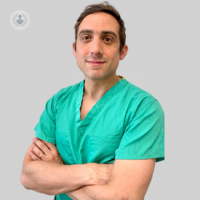Breast augmentation: risks, benefits, and recovery time
Escrito por:Breast augmentation is the topic up for discussion in one of our latest medical articles here below, as reputable consultant breast surgeon, Mr Andrew Pieri, tells us in detail how breast augmentation is performed, before outlining the advantages of undergoing this type of surgery.

What is a breast augmentation, and how is it performed?
Breast augmentation is a type of surgery that increases the size of the breasts and enhances their shape. The procedure can be performed either through the transfer of fat from an area of your body or through surgically inserting breast implants. The procedure typically involves the following steps:
1. Usually, general anaesthetic is administered to the patient, although implant surgery can be performed awake.
2. Once the patient is asleep, an anaesthetist will often perform a nerve block which results in far less post-op pain in the first week or two (most patients require only paracetamol or no painkillers at all)
2. The surgeon makes an incision in one of several possible locations: inframammary fold (crease under the breast) or around the areola are most common.
3. The surgeon creates a pocket either directly behind the breast tissue or underneath your chest wall muscle depending on the assessment and discussion in clinic prior to surgery. It’s important to make sure to keep the pocket as small as possible so that the chosen implant fits perfectly. If the pocket is made too big, the implant will move outwards creating a wider gap between the breasts at the cleavage. A pocket that is too wide also increases the risk of implant rotation or implant flipping.
4. The surgeon places the implant into the pocket. This should be performed using a special insertion funnel rather than the old-fashioned way of pushing it in with fingers. This is because there is a growing body of evidence that a funnel insertion reduces capsular contracture in the longer term (capsular contracture is the most common reason for needing revisional surgery in the future).
5. Finally, the incisions are closed in multiple layers of dissolvable sutures under the skin.
What are the benefits of undergoing breast augmentation surgery?
The benefits of breast augmentation include restoring breast volume lost after weight reduction or pregnancy, achieving a more rounded breast shape, and/or improving natural breast size asymmetry.
What are the associated risks?
There are a handful of risks associated with breast augmentation surgery. These include the following:
- capsular contracture
- scarring
- infection
- implant rupture
- wrinkling of the skin around the implant site (“rippling”)
- breast pain
- ALCL (anaplastic large cell lymphoma)
How long does it take to recover from breast augmentation surgery?
Most patients can return to work within a week or two after surgery, but it may take several weeks before you can resume normal activities, particularly upper body exercise
How long do breast implants last?
Breast implants are not designed to last a lifetime. Patients may need to have the implants replaced if they experience complications or if they decide that they want to change the size of their breasts.
To book a consultation with Mr Andrew Pieri, visit his Top Doctors profile today.


